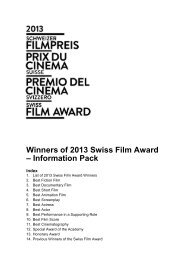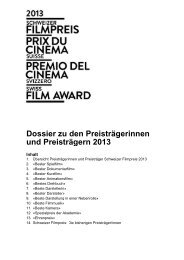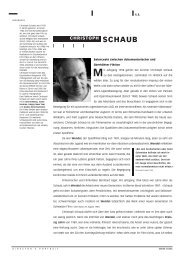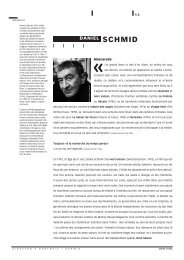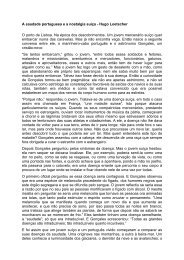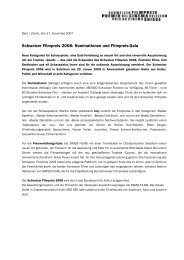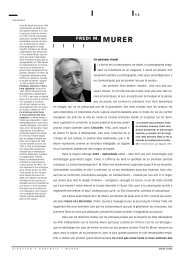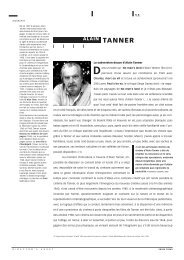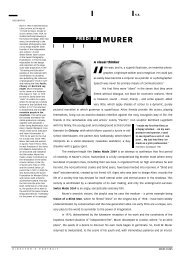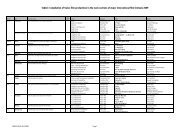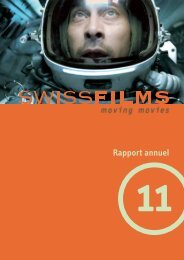Director's Portrait Daniel Schmid - Swiss Films
Director's Portrait Daniel Schmid - Swiss Films
Director's Portrait Daniel Schmid - Swiss Films
You also want an ePaper? Increase the reach of your titles
YUMPU automatically turns print PDFs into web optimized ePapers that Google loves.
Script: <strong>Daniel</strong> <strong>Schmid</strong><br />
Cinematographer: Renato Berta<br />
Sound: Dieter Meyer<br />
Editing: <strong>Daniel</strong>a Roderer<br />
Music: Liszt, Puccini, Chow Hsuan,<br />
Lecuona Cuban Boys<br />
“There are two things that have to<br />
be said about The Written Face. First,<br />
it is probably <strong>Daniel</strong> <strong>Schmid</strong>’s best<br />
film. Secondly, it is less a documentary<br />
about the Kabuki Theatre than<br />
a new variant of the film-maker’s<br />
reflections (...), a cross between an<br />
essay and a poem.”<br />
Jacques Mandelbaum, Le Monde, Paris (1996)<br />
Cast: Tamasaburo Bando, Kazou Ohno,<br />
Han Takehara, Haruko Sugimura,<br />
Yajuro Bando, Kai Shishido, Toshiya<br />
Nagasawa, Asaji Tsutakiyokomatsu<br />
his idols. This focuses on his meetings with geisha and dancer Han Takehara, movie actress Haruko<br />
Sugimura (Ozu, Naruse, Kurosawa) and Butoh dancer Kazuo Ohno. The third act, “Twilight Geisha”,<br />
is a playful variation on the geisha theme. In the fourth and final act Tamasaburo dances the Kabuki<br />
piece “Sagimusume”, a story of the reincarnation and metamorphosis of a young girl on a snowy<br />
winter’s night.<br />
Production: Marcel Hoehn,<br />
Kenzo Horikoshi<br />
T+C Film, Zürich (Marcel Hoehn)<br />
Eurospace, Tokyo<br />
World Rights: T&C Edition<br />
Original Version: Japanese<br />
THE WRITTEN FACE<br />
“I love things that are gone,” says<br />
<strong>Swiss</strong> film-maker and opera producer<br />
<strong>Schmid</strong>, paying tribute to a vanishing,<br />
alien culture. This is a hymn<br />
to the beauty of art. <strong>Schmid</strong> transforms<br />
the body of Onnagata, the<br />
101-year-old geisha, and the 88-yearold<br />
Butoh dancer into fiction. A few<br />
gestures are sufficient for him to<br />
sketch the other sex or convey a<br />
sense of perfect beauty, but without<br />
the frail figure behind it disappear-<br />
1995 (blow-up from Super-16)/35 mm<br />
89’ original title: The Written Face<br />
ing completely. In <strong>Schmid</strong>’s film<br />
people are works of art.”<br />
Christiane Peitz, Die Zeit (20 Sept.1996)<br />
he Written Face gravitates around Tamasaburo Bando, star of the Japanese Kabuki theatre.<br />
T The film is divided into four overlapping acts. The first, the dance of the drunk serpent Orochi,<br />
from Japan’s oldest myth, is followed by a second, documentary section on Tamasaburo Bando and<br />
F I C T I O N F I L M S / S C H M I D<br />
SWISS FILMS



